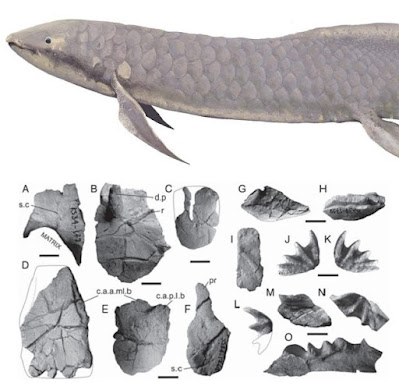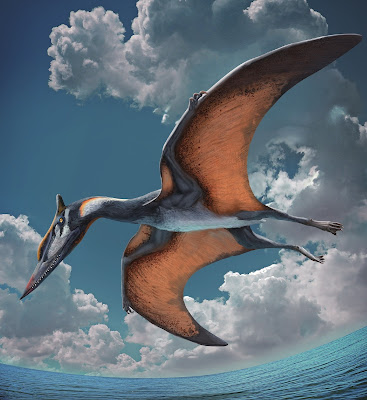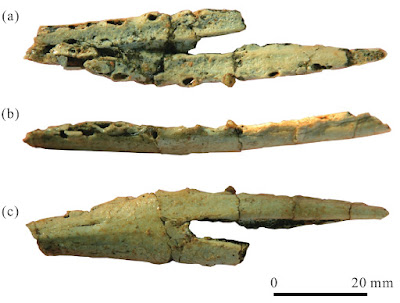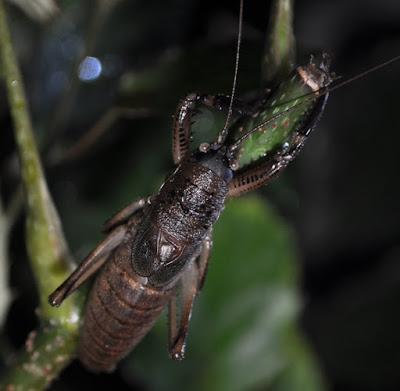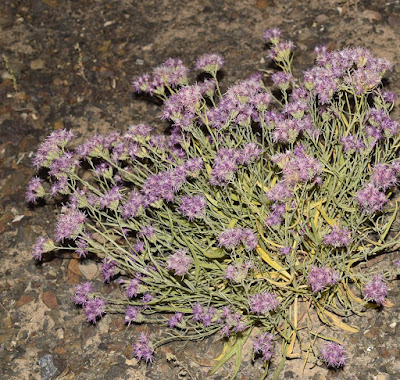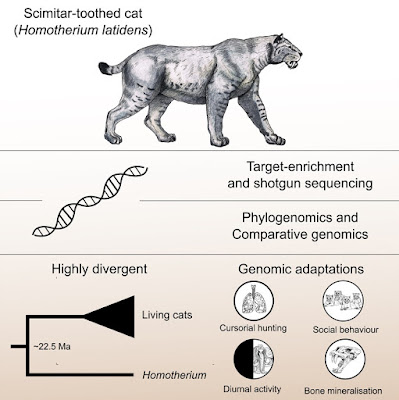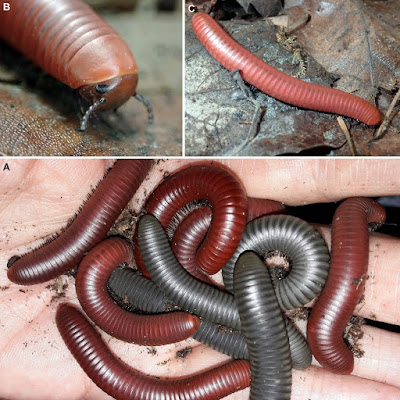[Most Recent Entries] [Calendar View]
Friday, October 16th, 2020
| Time | Event | ||||
| 2:02a | [PaleoIchthyology • 2020] Ferganoceratodus annekempae | เฟอร์กาโนเซราโตดัส แอนน์เคมเป • A New Lungfish (Sarcopterygii: Dipnoi) from the Jurassic of Thailand
SYSTEMATIC PALEONTOLOGY Subclass SARCOPTERYGII Romer, 1955 Order DIPNOI Müller, 1845 NEODIPNOI Agnolin, 2010 sensu Kemp, Cavin, and Guinot, 2017 Suborder CERATODONTOIDEI Nikolski, 1954 sensu Kemp, Cavin, and Guinot, 2017 Genus FERGANOCERATODUS Kaznyshkin and Nessov, 1985 (in Nessov and Kaznyshkin, 1985) Type Species— Ferganoceratodus jurassicus Kaznyshkin and Nessov, 1985. Referred Species— Ferganoceratodus szechuanensis (Young, 1942); F. martini Cavin, Suteethorn, Buffetaut, and Tong, 2007. FERGANOCERATODUS ANNEKEMPAE, sp. nov. Etymology— Species dedicated to Anne Kemp for her contribution to the study of lungfishes, past and present, and for her engagement in the protection of the Australian lungfish. Locality and Horizon— Phu Noi, Tambon Din Chi, Kam Muang district, Kalasin province, northeastern Thailand. Lower part of the Upper Phu Kradung Formation, Upper Jurassic. Lionel Cavin, Uthumporn Deesri and Phornphen Chanthasit. 2020. A New Lungfish from the Jurassic of Thailand. Journal of Vertebrate Paleontology. e1791895. DOI: 10.1080/02724634.2020.1791895 นักวิจัย ค้นพบปลาปอดชนิดใหม่ของโลก จากแหล่งซากดึกดำบรรพ์ภูน้อย จ.กาฬสินธุ์ kalasinnews.com/news1/8-news/3220 | ||||
| 2:05a | [Paleontology • 2020] Ordosipterus planignathus • First Record of Early Cretaceous Pterosaur (Pterosauria: Dsungaripteridae) from the Ordos Region, Inner Mongolia, China
ABSTRACT A new dsungaripterid pterosaur, Ordosipterus planignathus gen. et sp. nov., is established on the incomplete articulated lower jaws from the Lower Cretaceous Luohandong Formation in Otog Qi, Ordos Region, Inner Mongolia, China. It differs from other dsungaripterids mainly by having broad and low dentary at and just behind the mandibular symphysis, flat dentary dorsal plane forming the distinct lateral ridge with the curved dentary lateral side, and lower alveoli arranged along the dentary dorsolateral margin with wide spacing that increases from rostral to caudal. It represents the first diagnostic pterosaur from the Ordos Region in Inner Mongolia, and further enlarges the geographical distribution of the family Dsungaripteridae from northwestern China (together with western Mongolia) to central North China. Keywords: Pterosauria, Dsungaripteridae, Early Cretaceous, Ordos Region, Inner Mongolia, China
Order Pterosauria Kaup, 1834 Suborder Pterodactyloidea Plieninger, 1901 Family Dsungaripteridae Young, 1964 Genus Ordosipterus gen. nov. Type species. Ordosipterus planignathus gen. et sp. nov. Etymology. Ordos, referring to the Ordos Region of Inner Mongolia; pterus (Greek), meaning wing, the common suffix of pterosaur taxa. Ordosipterus planignathus gen. et sp. nov. Etymology. Plani- (Latin) and gnathus (Greek), meaning flat and jaw, referring to the flat lower jaws of the new pterosaur. Holotype. IG V13-011 (Institute of Geology, Chinese Academy of Geological Sciences), anterior portion of articulated lower jaws with a partial tooth and several alveoli (Figs. 2, 3). Type locality and horizon. Xinzhao, Otog Qi, Inner Mongolia Autonomous Region, China; lower part of Luohandong Formation, Zhidan Group, Lower Cretaceous. Diagnosis: Distinguished from other dsungaripterids in having broad and low dentary at and just behind the mandibular symphysis, a weak ventral median ridge present at least at the middle portion of symphysis, flat dentary dorsal plane forming the distinct lateral ridge with the curved dentary lateral side, lower alveoli arranged along the dentary dorsolateral margin with wide spacing that increases from rostral to caudal, the distance between two adjacent alveoli about 1.5 times to 3 times the rostrocaudal diameter of the front alveolus. Conclusion: The Early Cretaceous Ordosipterus planignathus gen. et sp. nov. represents the first convincible pterosaur from the Ordos Region in Inner Mongolia, and the second pterosaur taxon from the Ordos Basin after Huanhepterus quingyangensis in Gansu Province. As a member of family Dsungaripteridae, Ordosipterus enlarges the geographical distribution of the dsungaripterid pterosaurs from the northwestern China (with western Mongolia) to central North China. This fossil further strengthens the opinion that the northern China and Mongolia belong to a unique and endemic dinosaur biogeographic realm featured by the presence of Psittacosaurus and pterosaurs during the Early Cretaceous period. Shu-An Ji. 2020. First Record of Early Cretaceous Pterosaur from the Ordos Region, Inner Mongolia, China. China Geology. 3(1); 1-7. DOI: 10.31035/cg2020007 | ||||
| 2:30a | [Entomology • 2020] Cryptic New Species of Nesoecia Scudder, 1893 (Orthoptera: Tettigoniidae; Pseudophyllinae) from northeastern, Mexico
Abstract Nesoecia Scudder, 1893 is a neotropical genus of true katydids (Pseudophyllinae) comprising four species: N. brasiliensis (Bruner, 1915) from Brazil (Bahia), N. cooksonii (Butler, 1877) from Ecuador (Galápagos, Floreana Island), and two species from southern Mexico: N. insignis (Hebard, 1932) from Yucatán (Temax and Chichen-Itza), and N. nigrispina (Stål, 1873) reported also from Yucatán and the State of Tabasco (Teapa). Members of this genus are large and attractive insects, nonetheless, they have been poorly studied since they are not abundant or commonly collected. This paper describes four new species of Nesoecia from the Huasteca Region in northeastern México: N. huichihuayan n. sp., N. potoniya n. sp., N. insolita n. sp., and N. constricta n. sp. Taxa delimitation is based on morphological diagnostic characters and parameters of the acoustic signal. Information on distribution, habitat, and behavior is provided. Keywords: Orthoptera, Pseudophyllinae, true katydids, morphology, acoustic signal, behavior Ludivina Barrientos-Lozano, Aurora Y. Zaldívar-Riverón, Geovany J. Fernández-Azuara, Uriel Jeshua Sánchez-Reyes and Pedro Almaguer-Sierra. 2020. Cryptic New Species of Nesoecia Scudder, 1893 (Orthoptera: Tettigoniidae; Pseudophyllinae) from northeastern, Mexico. Zootaxa. 4859(4); 451–486. DOI: 10.11646/zootaxa.4859.4.1 | ||||
| 2:46a | [Botany • 2020] Saussurea xinjiangensis (Asteraceae) • A New Species from Xinjiang, China
Abstract Saussurea xinjiangensis Y. S. Chen, a new species from Xinjiang, China, is described and illustrated. It was first found during a field expedition by the author in 2014. It belongs to S. subgen. Saussurea sect. Laguranthera because its root and caudex split fibrously and it has numerous capitula in a corymbiform synflorescence. The new species is similar to S. mucronulata in its habit, strongly fibrous rootstock and caudex, sessile linear leaves and capitula shortly pedunculated in a corymbiform synflorescence. However, it differs from S. mucronulata by its usually branched stems (versus usually simple or apically few‐branched), lower leaf blade 8–12 cm long and 0.5–1.8 cm wide (versus 3–5 cm long and 0.2–0.5 cm wide), leaves abaxially sparsely arachnoid tomentose (versus densely arachnoid tomentose), phyllary white arachnoid tomentose and green to brown (versus glabrous and blackish purple). Keywords: Compositae, new taxon, Saussurea sect. Laguranthera, taxonomy
You‐Sheng Chen and Lian‐Sheng Xu. 2020. Saussurea xinjiangensis sp. nov. (Asteraceae, Cardueae), A New Species from Xinjiang, China. Nordic Journal of Botany. 38(9); DOI: 10.1111/njb.02711 | ||||
| 3:42a | [PaleoMammalogy • 2020] Genomic Adaptations and Evolutionary History of the Extinct Scimitar-Toothed Cat, Homotherium latidens
Highlights: • Nuclear genome and exome analyses of extinct scimitar-toothed cat, Homotherium latidens • Homotherium was a highly divergent lineage from all living cat species (∼22.5 Ma) • Genetic adaptations to cursorial and diurnal hunting behaviors • Relatively high levels of genetic diversity in this individual Summary Homotherium was a genus of large-bodied scimitar-toothed cats, morphologically distinct from any extant felid species, that went extinct at the end of the Pleistocene. They possessed large, saber-form serrated canine teeth, powerful forelimbs, a sloping back, and an enlarged optic bulb, all of which were key characteristics for predation on Pleistocene megafauna. Previous mitochondrial DNA phylogenies suggested that it was a highly divergent sister lineage to all extant cat species. However, mitochondrial phylogenies can be misled by hybridization, incomplete lineage sorting (ILS), or sex-biased dispersal patterns, which might be especially relevant for Homotherium since widespread mito-nuclear discrepancies have been uncovered in modern cats. To examine the evolutionary history of Homotherium, we generated a ∼7x nuclear genome and a ∼38x exome from H. latidens using shotgun and target-capture sequencing approaches. Phylogenetic analyses reveal Homotherium as highly divergent (∼22.5 Ma) from living cat species, with no detectable signs of gene flow. Comparative genomic analyses found signatures of positive selection in several genes, including those involved in vision, cognitive function, and energy consumption, putatively consistent with diurnal activity, well-developed social behavior, and cursorial hunting. Finally, we uncover relatively high levels of genetic diversity, suggesting that Homotherium may have been more abundant than the limited fossil record suggests. Our findings complement and extend previous inferences from both the fossil record and initial molecular studies, enhancing our understanding of the evolution and ecology of this remarkable lineage. Keywords: Homotherium, paleogenome, genomics, comparative genomes, adaptation, phylogeny, ancient DNA, palaeogenome, diversity, selection Ross Barnett, Michael V. Westbury, Marcela Sandoval-Velasco, Filipe Garrett Vieira, Sungwon Jeon, Grant Zazula, Michael D. Martin, Simon Y.W. Ho, Niklas Mather, Shyam Gopalakrishnan, Jazmín Ramos-Madrigal, Marc de Manuel, M. Lisandra Zepeda-Mendoza, Agostinho Antunes, Aldo Carmona Baez, Binia De Cahsan, Greger Larson, Stephen J. O’Brien, Eduardo Eizirik, Warren E. Johnson, Klaus-Peter Koepfli, Andreas Wilting, Jörns Fickel, Love Dalén, Eline D. Lorenzen, Tomas Marques-Bonet, Anders J. Hansen, Guojie Zhang, Jong Bhak, Nobuyuki Yamaguchi and M. Thomas P. Gilbert. 2020. Genomic Adaptations and Evolutionary History of the Extinct Scimitar-Toothed Cat, Homotherium latidens. Current Biology. DOI: 10.1016/j.cub.2020.09.051 | ||||
| 4:32a | [Diplopoda • 2020] Dichromatobolus elephantulus • A New Genus of Spirobolidan Millipedes (Spirobolida, Pachybolidae) from Madagascar Abstract A new genus, Dichromatobolus gen. nov., belonging to the genus-rich mainly southern hemisphere family Pachybolidae of the order Spirobolida, is described based on Dichromatobolus elephantulus gen. et sp. nov., illustrated with color pictures, line drawings, and scanning electron micrographs. The species is recorded from the spiny bush of southwestern Madagascar. Dichromatobolus elephantulus gen. et sp. nov. shows an unusual color pattern, sexual dichromatism with males being red with black legs and females being grey. Males seem to be more surface active, as mainly males were collected with pitfall traps. Females mainly come from the pet trade. The body of this species is short and very wide, being only 8 times longer than wide in the males. Live observations show the species is a very slow mover, digging in loose soil almost as fast as walking on the surface. The posterior gonopods of Dichromatobolus gen. nov. are unusually simple and well-rounded, displaying some similarities to the genera Corallobolus Wesener, 2009 and Granitobolus Wesener, 2009, from which the new genus differs in numerous other characters, e.g., size, anterior gonopods and habitus. Despite several attempts with fresh tissue samples and different primers, molecular barcoding did not work for Dichromatobolus gen. nov. Any relationships to the other 15 genera of Pachybolidae indigenous to Madagascar remain unknown. Keywords: biodiversity, Mahafaly Plateau, spiny forest, sexual color dimorphism, soil arthropod Class Diplopoda de Blainville in Gervais, 1844 Order Spirobolida Cook, 1895 Family Pachybolidae Cook, 1897 sensu Hoffman 1980 Dichromatobolus gen. nov. Diagnosis: Massive, short, differs from all other known genera of Pachybolidae in mature males being only eight times longer than wide. Coloration uniquely differing between sexes, females grey, males red (Fig. 1A). Transverse ridge on mentum of gnathochilarium absent (Fig. 4A). Male legs with tarsal pads and unusually spinose tarsi (Fig. 4D). Shares anterior telopods with apical process of telopodite (Fig. 4E–F) with Zehntnerobolus Wesener, 2009, from which Dichromatobolus gen. nov. differs strongly in habitus and posterior gonopods. Simple, apically swollen posterior gonopods (Fig. 5A–C) are shared with Corallobolus Wesener, 2009, from which Dichromatobolus gen. nov.differs in habitus and anterior telopods. Etymology: After the differences in the color pattern between the sexes, and ʻ-bolusʼ, a common suffix for genus names of the Spirobolida. Masculine. Taxonomic position: The posterior gonopods being connected by a sclerotized sternite as well as the absence of apodemes on the anterior gonopods (Fig. 4E–F) place Dichromatobolus gen. nov. in the suborder Trigoniulidea Attems, 1909, family Pachybolidae. The closest relative of Dichromatobolus gen. nov. is unknown. Remarks: There is a second potential species, > 100 mm in length, with specimens from Manongarivo, Ananambao (FMNH-INS 56254), all unfortunately female. Their wide body with short legs and grey color (all other larger Spirobolida genera on Madagascar are black/red, Wesener et al. 2009) might indicate a relationship to Dichromatobolus gen. nov. Dichromatobolus elephantulus gen. et sp. nov. Diagnosis: Body 60–80 mm long, massive, bulky spirobolidan. Epiproct not projecting. Males red, females grey, ozopore openings in both sexes marked by a black circle. Males with tarsal pads, coxa projections absent. Legs and antennae short. Anterior gonopods, telopodite process well-developed and at apex curved laterally. Posterior gonopod slender and elongated, telopodite simple, rectangular, apically with opening of efferent duct. Etymology: Elephantulus, diminutive noun in apposition, after the resemblance to an elephant in the female grey color, as well as a hint referring to the width of the species. Thomas Wesener. 2020. Dichromatobolus, A New Genus of Spirobolidan Millipedes from Madagascar (Spirobolida, Pachybolidae). European Journal of Taxonomy. 720(1); 107-120. DOI: 10.5852/ejt.2020.720.1119 |
| << Previous Day |
2020/10/16 [Calendar] |
Next Day >> |
